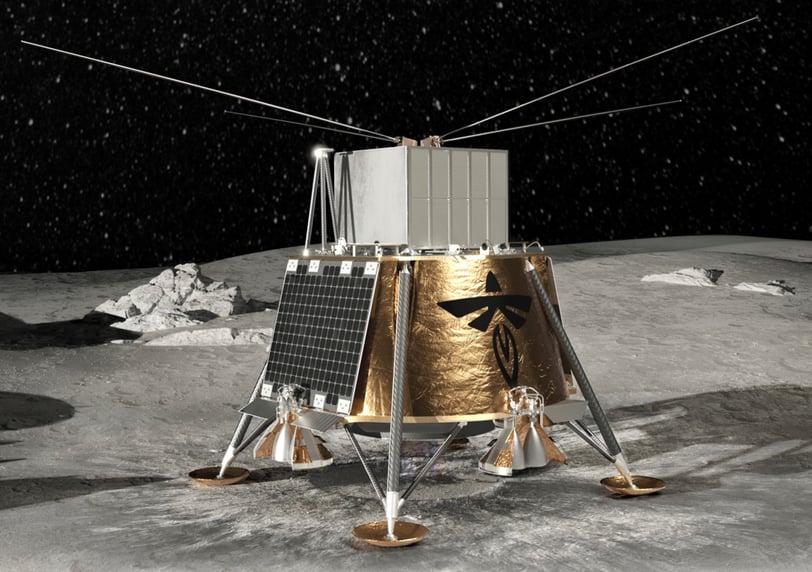Blue Ghost: The Private Lunar Mission Bringing Stunning New Views of the Moon
The Blue Ghost spacecraft, developed by Firefly Aerospace, is on the verge of making a historic lunar landing attempt on March 2, 2025. During its journey, the probe has captured breathtaking images of the Moon’s surface, providing detailed and unprecedented views of our natural satellite. This mission marks a crucial milestone in commercial space exploration, highlighting the increasing role of private companies in deep space missions.
2/24/20253 min read


The Blue Ghost Mission
Launched on January 15, 2025, aboard a SpaceX Falcon 9 rocket, the Blue Ghost mission is part of NASA's Commercial Lunar Payload Services (CLPS) program. The primary goal is to deliver ten scientific experiments and technology demonstrations to the Mare Crisium region, a geologically significant area on the visible side of the Moon. These experiments aim to deepen our understanding of the lunar environment and lay the groundwork for future crewed missions under the Artemis program.
In addition to NASA’s scientific payloads, Blue Ghost is carrying private commercial payloads, including advanced materials testing experiments, radiation shielding technologies, and even a lunar time capsule containing messages and artifacts meant to preserve human culture for future generations. These payloads showcase the growing interest of both governmental and commercial entities in establishing a sustainable lunar economy.
Stunning Images of the Moon
After a 4-minute, 15-second engine burn on February 13, 2025, Blue Ghost entered an elliptical lunar orbit. During this maneuver, the probe captured a series of high-resolution images of the Moon’s surface, showcasing craters, lunar maria, and other geological formations. These photographs serve not only for navigation and landing site planning but also offer the public a renewed perspective of the Moon. Firefly Aerospace has shared these images on its official platforms, emphasizing the mission's significance for commercial space exploration. (fireflyspace.com)
Some of these images have revealed previously uncharted details of the lunar terrain, highlighting variations in regolith composition and subtle surface changes caused by micrometeorite impacts. Scientists are using these images to refine their models of the Moon’s evolution and to identify potential future landing sites for both robotic and human exploration.
Preparations for the Landing
In the days leading up to the landing, Blue Ghost will perform a series of maneuvers to circularize its orbit and approach the lunar surface. The precision of these maneuvers is crucial to ensuring a safe and successful touchdown at the designated region. The Firefly Aerospace team is continuously monitoring the spacecraft’s systems and adjusting flight parameters as needed. The success of this mission will mark a significant milestone for both the company and private-sector lunar exploration.
One of the key challenges of this mission is the landing process itself. Unlike previous lunar landers operated by national space agencies, Blue Ghost relies on a combination of advanced terrain-relative navigation and autonomous landing algorithms to identify a safe landing spot in real time. This system, if successful, could pave the way for more precise and risk-mitigated lunar landings in future commercial missions.
Scientific and Technological Contributions
On board the Blue Ghost are instruments designed to collect data on lunar soil composition, measure radiation levels, and test new communication and navigation technologies. These investigations will provide valuable insights for future missions and help establish a sustainable human presence on the Moon. Additionally, the mission aims to demonstrate the viability of public-private partnerships in space exploration, paving the way for future collaborations.
Among the payloads, NASA’s Lunar Environment Monitoring Station (LEMS) will analyze the Moon’s thin exosphere, providing crucial data about how solar wind interacts with the lunar surface. Additionally, an experimental solar panel technology will be tested, designed to function in the harsh lunar environment and potentially power future habitats. Another key experiment is a thermal regulation system that could help mitigate extreme temperature fluctuations on the Moon’s surface, a critical factor for sustaining human missions.
The Future of Commercial Lunar Exploration
With the anticipated success of the Blue Ghost mission, Firefly Aerospace plans to increase the frequency of its lunar missions in the coming years. These initiatives aim not only at scientific exploration but also at developing infrastructure for activities such as space tourism, lunar resource mining, and the establishment of permanent bases. Collaboration between private companies and government agencies like NASA will be essential in turning these visions into reality and ushering in a new era of deep space exploration.
Additionally, the mission serves as a proving ground for new business models in space exploration. Companies are beginning to see the Moon not just as a scientific destination, but as a platform for commercial activities, such as in-situ resource utilization (ISRU), where lunar ice and regolith could be converted into usable materials for fuel, construction, and life support systems. The successful demonstration of such technologies could drastically reduce the cost of future deep space missions.
Conclusion
In summary, the Blue Ghost mission represents a significant step forward in lunar exploration, combining ambitious scientific objectives with private-sector innovation. The mission is not only providing critical scientific data but also proving the viability of commercial partnerships in space exploration. As the spacecraft prepares for its historic landing, the world eagerly awaits the new knowledge and opportunities that this mission will bring. The success of Blue Ghost could redefine the way humanity approaches space travel, bringing us closer to a future where the Moon becomes a gateway for deeper space exploration and long-term human settlement.
Explore
Discover diverse topics in one convenient hub.
Connect
Learn
contact@mindstormblog.com
© 2025. All rights reserved.

